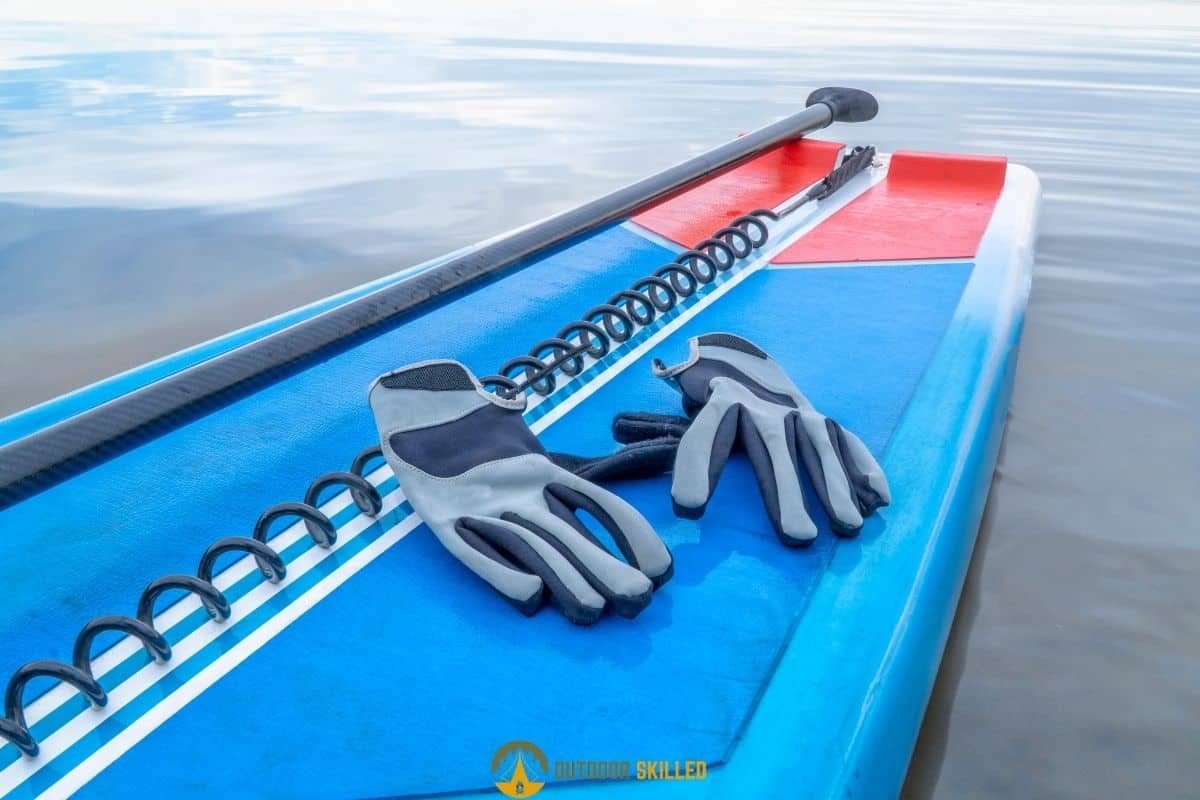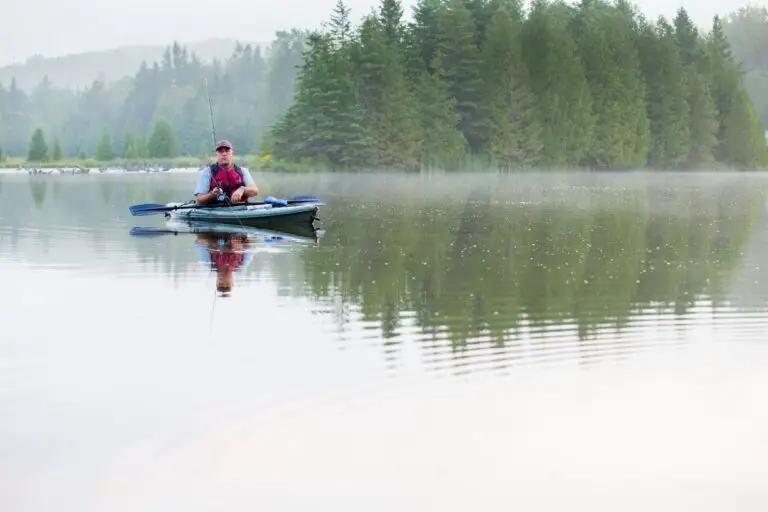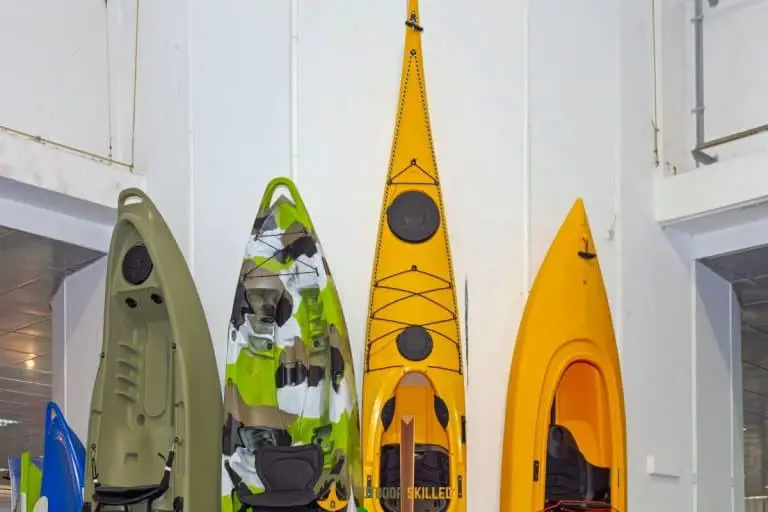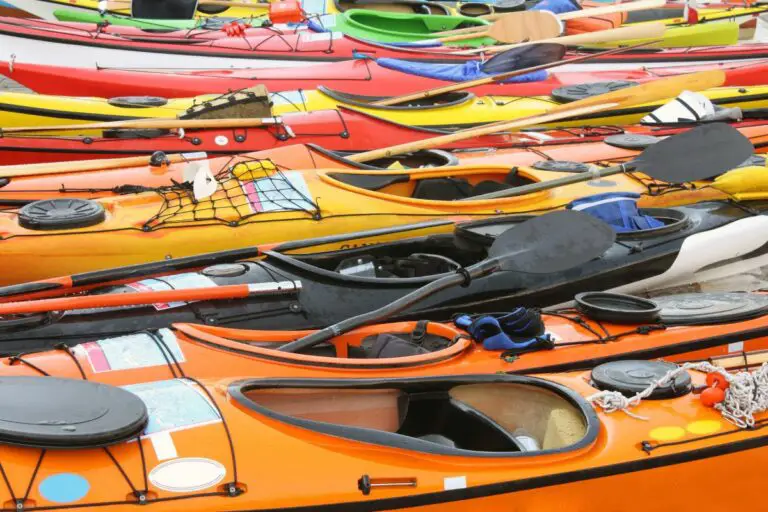When to Use a Kayak Paddle Leash? And How To Use it Easily and Effectively
Kayakers have mixed opinions when it comes to using kayak paddle leashes. Some kayakers think the leashes are beneficial and necessary to kayak safely, while others think they interfere with their paddling.
So, when to use a kayak paddle leash? You can use a kayak paddle leash if you’re going to be kayaking in an environment where you’re likely to drop your paddle in the water, such as in strong winds and currents or when you’re kayak fishing. The leashes will keep your paddle from floating away and make it easy to retrieve.
Keep reading to learn more about when to use a kayak paddle leash and how to use it effectively to prevent it from interfering with your paddling.
Table of Contents
What Is a Kayak Paddle Leash?

A kayak paddle leash is a piece of equipment that is used to anchor your paddle to your kayak to keep it safe.
It’s basically a cord that’s about 6 feet in length. One end of the cord is a fixed loop or carabiner clip that’s attached to your life vest or your kayak, while the other end of the cord is another loop or cuff that’s attached to the middle of the paddle to keep it secure.
When to Use a Kayak Paddle Leash?
You can use a kayak paddle leash if you’re kayaking in rough conditions like strong winds or currents, as you might accidentally drop your paddle. The leash will help prevent the paddle from floating away and make it easier to retrieve.
You also wouldn’t need to worry about your paddle in case of your kayak capsizes. If the paddle is secured to the kayak using the leash, it will be much easier for you to re-enter your kayak.
There are other situations where paddle leashes are useful, such as kayak fishing, as they will be able to handle your fishing equipment comfortably, and you can even clear out more space in your kayak by intentionally dropping the paddle in the water. This will make it easy for you to move around the cockpit with the paddle out of the way.
They’re also good to use if you’re kayaking at night. If you nod off and your paddle falls into the water, you may not be able to find it again in the dark.
Whether or not you need to use a paddle leash mainly depends on where you’re planning to kayak and the consequence of losing your paddle.
How to Use a Kayak Paddle Leash Correctly?
Paddle leashes tend to tangle, which is why many kayakers dislike them. It can be very dangerous if the paddle leashes get tangled in an emergency, such as your kayak capsizing.
So, it’s important to know how to use your paddle leash correctly and what to do if they get all tangled up.
It’s very unlikely that your body could get tangled up in the paddle leash in a way you can’t escape. However, it’s best to carry a knife within reach (in the pocket of your PFD) so that you can cut the cord of the paddle leash away and release your body.
If you are going to be kayaking with a paddle leash in the ocean, it’s recommended to remove the leash when entering and exiting the surf zone as there is more risk of entanglement if you capsize in a surf zone. You can re-attach the leash when beyond the surf zone.
How to Attach Your Paddle Leash?
There are many ways you can attach your paddle leash.
One of the ends of the paddle leash can be attached to the paddle by a velcro cuff or in a loop over the paddle blade.
The other end of the leash can be attached in different places:
- You can attach the leash to the kayak itself using the D-ring on the side, or you attach it to the bungee cord rigging on the top of the front deck. The position allows you to paddle without any interference from the cord
- You can also attach the leash to your PFD or your wrist. However, these options are not very recommended as you’ll be putting yourself in danger by risking getting tangled in the cord of the leash if you capsize your kayak, which could result in a serious injury.
How to Choose the Best Paddle Leash for You?

There are some important factors you need to consider before you buy a paddle leash. Let’s break down these factors in detail.
The Length and Flexibility of the Leash
A paddle leash ideally needs to be at least 4 feet long when it’s completely stretched. When it’s not stretched, it’s usually less than 4 feet.
It’s important to make sure its length is not less than 3.5 feet as this will cause some resistance to the paddle’s movement and will also hinder the placement of the paddle anywhere in the kayak.
It can be a good idea to go over the ideal length of 6 feet because leashes can easily get snagged in things easily.
The Material and Color of the Leash Covering
Paddle leash covers are made of two kinds of material – stretchable nylon or vinyl.
Nylon is a commonly used material, and it is highly durable. However, it’s not completely waterproof, so it comes with a waterproof coating. Vinyl, on the other hand, is made with waterproof fabric.
Another thing to keep in mind is the color of the leash cover. It’s recommended to go for a brightly colored paddle leash in shades like orange, yellow, or red so that it can stand out against the water. Increasing the visibility of the leash on the water surface will provide more safety.
The Material of the Coil
The material used to make the coil in most kayak paddle leashes is usually stainless steel. That is because it’s waterproof and strong.
Some coils are made from aluminum; however, it’s not recommended to go for those because they are not very durable and can be snapped easily.
What Are the Types of Paddle Leashes?
There are three different kinds of leashes. Let’s take a look at the properties of each kind.
Coiled Leashes

These paddle leashes are made from coils of stretchy material and they come with vinyl or plastic covers.
They’re very easy to stretch, so they don’t interfere with your paddling. They don’t snag or drag in the water to reduce your speed.
The inner core of the leash is made of stainless steel, so it won’t extend much beyond its length.
Bungee leashes

These paddle leashes are made from professional bungee cords on the inside, and they usually come with a nylon cover.
They’re much more versatile when it comes to length and flexibility. They can also withstand more stretch and strain
However, they’re likely to lose their retraction abilities over time.
Straight Cable Leashes

These paddle leashes are made from a single line of stretchable nylon and come with an adjustable stopper at one end, which allows you to adjust the cable length according to your needs.
They’re highly versatile and can be used in various ways, such as temporary dock lines, tying watercraft together, and kayak tie-downs.
They can stretch more compared to coiled leashes; however, they have lower durability.
Where to Buy Kayak Paddle Leashes?
You can find kayak paddle leashes in most kayak supply stores, or you can easily purchase them online. Their prices usually range from $10 to $20, so they’re very affordable.
Take a look at the top picks for kayak paddle leashes that are currently available on Amazon.
The Best Kayak Paddle Leashes on Amazon
The top recommendation for a kayak paddle leash is the Wonitago Stretchable Kayak Paddle Leash.

- It’s brightly colored and made from a durable rubber material with a nylon covering. It’s highly resistant to corrosion and doesn’t lose its elasticity or stretch over time.
- It can be stretched from 49 inches up to 75 inches, which is perfect for most users. It also has an adjustable velcro end making it very easy to attach, use, and detach.
- For all the benefits this leash offers, it can be slightly more expensive.
The second recommendation is the YYST Paddle Leash.

- It comes in a bright red color that’s easily visible on the water, and it’s one of the best paddle leashes for several reasons. It can be used for your kayak paddle and also other kayak fishing accessories such as a fishing net pole and a fishing rod.
- It’s available in single as well as multiple packs and costs less than $10.
- It’s durable, resistant to corrosion, and can retain its strength for multiple years. However, it’s considered short when compared to other paddle leashes, as it only stretches to 36 inches.
- It’s easy to use as it can be easily warped around the shaft of your rod or paddle and clipped on the kayak’s D-rings.
- It comes with a clip made from a high-quality plastic material as well as an adjustable cord loop.
The final recommendation is this useful set of Camping and kayaking Paddle Leashes.

- This set comes with 3 black gear leashes. One of them can be used for your paddle, and the two additional leashes can be used as spares for attaching rods or other light gear.
- The leashes are 20 inches long and can stretch up to 40 inches. You can also attach all 3 leashes together to make one extra-long leash.
- It’s long-lasting due to its excellent woven structure. It’s not going to lose its elasticity or over-stretch with frequent use.
DIY Kayak Paddle Leashes
Commercial paddle leashes can be too long or too heavy, so the best solution is to make your own DIY leash with the length and weight you need.
You can use a shock cord with a fixed loop or a lightweight carabiner to attach the leash to the kayak, then use a lightweight Velcro cuff to attach the leash to the paddle.
You’re likely to face some problems with the velcro attachment, as it’s the weakest link.
- Make sure the Velcro straps are long enough to be warped two or three times around the paddle to keep them from coming undone.
- You also need to periodically apply a rubber or silicon spray on the inside of the Velcro straps to keep them from sliding along the paddle and keep the leash stable.
Related Questions
Do Kayak Paddles Float On Water?
Paddles do float on water. However, some kayak paddles float better than others, and how well they float mainly depends on several factors, such as the weight of the paddle, the material used to manufacture it, and the shape and feathering of the blades.
What Is a Paddle Float?
A paddle float is a small inflatable bladder or cushion that’s attached to the blade of the paddle and strapped to the shaft. It’s basically used to keep the paddle afloat and help stabilize kayakers when they attempt to re-enter the kayak from the water in case of capsizing.
Kayak your way to Freedom
- On a budget? Check out the best fishing kayaks under $500 here and the best Fishing Kayaks under $1,000 here. Or Check the best Cheap Kayaks here.
- Going fishing? Here are the best Ocean fishing kayaks, and here are the best River Fishing Kayaks.
- You can also find the best Fly Fishing Kayaks here and the best Bass Fishing Boats here.
- A bit experienced? Check out the best modular kayaks here and the best tandem fishing kayaks here.
- Looking for something special? Check out my favorite Ducky kayaks here.
- Navigate your way with these awesome and beginner-friendly Kayak compasses.
- Going Hunting? These Duck hunting kayaks will give you an unfair advantage!
- Have a need for speed? These motorized kayaks will get you moving.
- Protect yourself from the sun with these Kayak shades, and make your kayak more comfortable with these Kayak seats.
- Keep your feet dry and warm with these superb Kayaking shoes.
- Going Kayaking in cold water? Stay warm with these Kayaking gloves.
- Paddle Less, Fish More with the Best Kayak Motors
- Looking to get a trolling motor on your kayak? Check out the best kayak trolling motor mounts here.
Helpful Resources
Recreational Kayaking: The Ultimate Guide By Ken Whiting (you can also check the book on Amazon here)







![The 6 Best Kayak Shades and Canopies [Real-Life Tests, 2023]](https://outdoorskilled.com/wp-content/uploads/2021/07/best-kayak-shades-featured-768x512.jpg)
